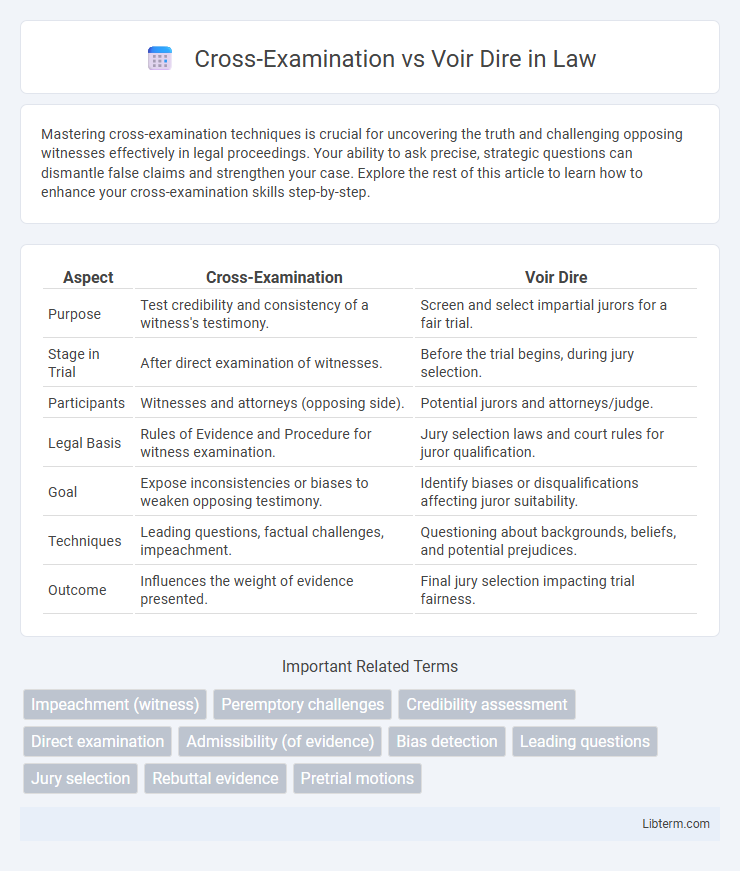Mastering cross-examination techniques is crucial for uncovering the truth and challenging opposing witnesses effectively in legal proceedings. Your ability to ask precise, strategic questions can dismantle false claims and strengthen your case. Explore the rest of this article to learn how to enhance your cross-examination skills step-by-step.
Table of Comparison
| Aspect | Cross-Examination | Voir Dire |
|---|---|---|
| Purpose | Test credibility and consistency of a witness's testimony. | Screen and select impartial jurors for a fair trial. |
| Stage in Trial | After direct examination of witnesses. | Before the trial begins, during jury selection. |
| Participants | Witnesses and attorneys (opposing side). | Potential jurors and attorneys/judge. |
| Legal Basis | Rules of Evidence and Procedure for witness examination. | Jury selection laws and court rules for juror qualification. |
| Goal | Expose inconsistencies or biases to weaken opposing testimony. | Identify biases or disqualifications affecting juror suitability. |
| Techniques | Leading questions, factual challenges, impeachment. | Questioning about backgrounds, beliefs, and potential prejudices. |
| Outcome | Influences the weight of evidence presented. | Final jury selection impacting trial fairness. |
Introduction to Cross-Examination and Voir Dire
Cross-examination is a critical phase in trial advocacy where attorneys question witnesses presented by the opposing party to challenge their testimony and credibility. Voir dire serves as a preliminary jury selection process, allowing attorneys to question potential jurors to identify biases and ensure an impartial jury. Both processes are essential for shaping the evidentiary and decision-making framework of a trial.
Defining Cross-Examination
Cross-examination is a critical phase in a trial where the opposing attorney questions a witness to challenge the credibility and accuracy of their testimony. This process aims to uncover inconsistencies, biases, or errors in the witness's statements to weaken the opposing party's case. Unlike voir dire, which focuses on selecting an impartial jury, cross-examination directly tests the reliability of evidence presented in court.
Understanding Voir Dire
Voir dire is a crucial pretrial process where attorneys and judges question potential jurors to assess their biases, qualifications, and suitability for jury duty. This examination aims to ensure an impartial jury by identifying any prejudices or conflicts of interest that could affect the trial's fairness. Unlike cross-examination, which challenges evidence and witness credibility during trial, voir dire serves as a jury selection tool to safeguard the integrity of the judicial process.
Key Differences Between Cross-Examination and Voir Dire
Cross-examination is a phase during trial where attorneys question witnesses presented by the opposing party to challenge their testimony and uncover inconsistencies, focusing on facts relevant to the case. Voir dire precedes the trial and involves the jury selection process, where attorneys and judges question potential jurors to assess biases and suitability for serving on the jury. The key difference lies in cross-examination assessing witness credibility during the trial, while voir dire evaluates juror impartiality before the trial begins.
Purpose and Objectives of Cross-Examination
Cross-examination serves to test the credibility, reliability, and truthfulness of a witness's testimony by challenging inconsistencies, biases, and inaccuracies through targeted questioning. It aims to weaken the opponent's case by exposing contradictions and highlighting facts favorable to the examining party. The core objective is to ensure that the jury or judge attains a clearer, more accurate understanding of the evidence presented.
Purpose and Objectives of Voir Dire
Voir dire serves the purpose of selecting an impartial jury by questioning prospective jurors about their backgrounds, beliefs, and potential biases to ensure fairness in the trial. Its primary objective is to identify any factors that may compromise a juror's ability to remain objective, thereby safeguarding the defendant's right to an unbiased jury. Unlike cross-examination, which challenges the credibility of witnesses during trial, voir dire occurs before the trial to shape the jury composition.
Legal Procedures and Timing
Cross-examination occurs during the trial phase, focusing on challenging the credibility of witnesses through direct questioning after the initial testimony. Voir dire takes place before the trial begins, serving as a jury selection process to identify unbiased jurors through questioning by attorneys and the judge. Both procedures are critical in ensuring fair trial outcomes but are distinctly timed and serve different legal functions.
Strategies for Effective Cross-Examination
Effective cross-examination requires meticulous preparation, focusing on controlling the narrative by asking precise, leading questions that limit the witness's ability to provide explanations. Strategic use of inconsistencies in testimony and prior statements undermines credibility, while maintaining a calm, assertive demeanor enhances the lawyer's authority and persuasiveness in court. Mastering this technique increases the likelihood of exposing weaknesses in the opposing party's case and reinforcing key points for the jury.
Techniques for Successful Voir Dire
Techniques for successful voir dire include asking open-ended questions that reveal potential jurors' biases, backgrounds, and attitudes related to the case. Employing active listening helps attorneys gauge candid responses and tailor follow-up inquiries to uncover deeper insights. Utilizing challenges effectively ensures the selection of an impartial jury by removing those who exhibit prejudicial viewpoints or conflicts of interest.
Importance in the Legal Process
Cross-examination plays a crucial role in challenging witness credibility and uncovering inconsistencies, directly impacting case outcomes. Voir dire is essential for selecting impartial jurors, ensuring fair trials by screening bias or preconceived notions. Together, these procedures safeguard the integrity of the legal process and uphold the right to a fair trial.
Cross-Examination Infographic

 libterm.com
libterm.com